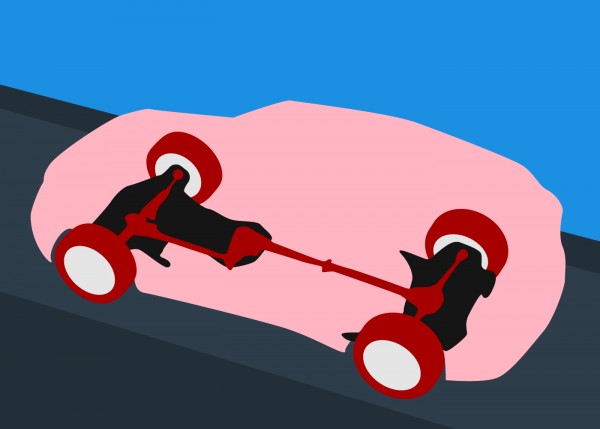The difference between AWD and 4WD lies in how they distribute power to the wheels, greatly affecting vehicle performance. At WHAT.EDU.VN, we unravel this crucial distinction. Understand the nuances, application, and benefits of AWD vs. 4WD. Explore traction control, off-road capabilities, and vehicle dynamics for informed choices.
1. Understanding 4WD (Four-Wheel Drive) Systems
Four-wheel drive (4WD) signifies that the engine delivers equal power to all four wheels. This is accomplished using a transfer case that distributes power through the vehicle’s two axles, ensuring each wheel rotates at the same rate. This setup enhances grip, traction, and overall power, making 4WD vehicles suitable for off-road driving and heavy towing. A 4WD system is robust and designed for challenging terrains. If you’re curious about other automotive technologies, ask your questions on WHAT.EDU.VN and get free answers from experts.
1.1. Exploring 4L and 4H Modes in 4WD
4WD systems typically offer two primary modes:
- 4L (Four-Wheel Drive Low Range): This mode employs a low gear ratio across all four wheels, providing increased torque at lower speeds. It’s ideal for soft surfaces like sand or mud and for navigating steep inclines.
- 4H (Four-Wheel Drive High Range): This mode provides enhanced traction on firmer surfaces such as gravel, dirt roads, and harder sand. It is suitable for higher-speed driving where additional grip is required.
1.2. The Definition of 4×4
The term “4×4” refers to a four-wheel drive system in vehicles with four wheels. This means all 4×4 vehicles are 4WD, but not all 4WD vehicles are 4x4s. For instance, a six-wheel truck with power distributed to all wheels is considered a 4WD but not a 4×4. The term “4×4” simply specifies the number of wheels and the number of powered wheels.
1.3. The Advantages and Drawbacks of 4WD
4WD vehicles generally offer superior off-road capabilities and are ideal for challenging driving conditions. However, they also tend to be heavier and less fuel-efficient than two-wheel-drive vehicles. They can be more expensive to purchase and maintain as well. Understanding these trade-offs is essential when considering a 4WD vehicle. For more detailed advice, ask automotive experts on WHAT.EDU.VN.
2. Delving into AWD (All-Wheel Drive) Systems
All-wheel drive (AWD) systems can vary the amount of power sent to each wheel, unlike 4WD systems that distribute power equally. This adaptability is achieved through mechanical or electronic means and typically requires no direct driver intervention. AWD systems often prioritize one axle, operating primarily as a two-wheel-drive vehicle and engaging the other axle as needed. Consider AWD for its versatility in varied driving conditions.
2.1. Different Types of AWD Systems
There are several types of AWD systems, each with its distinct characteristics:
- Full-Time AWD: This system continuously powers all four wheels, providing consistent traction in all driving conditions.
- Part-Time AWD: This system primarily operates in two-wheel drive, allowing the driver to manually engage the second axle when additional traction is needed, such as in slippery conditions.
- Automatic AWD: Similar to part-time AWD, this system automatically engages the second axle when it detects wheel slip, without requiring driver intervention.
- Selectable AWD: This system allows the driver to choose between two-wheel drive and four-wheel drive modes, offering flexibility for different driving situations.
2.2. When to Use AWD
AWD systems are particularly effective in situations where traction can vary, such as snowy or icy roads. They adapt to changing surface conditions by automatically adjusting the power distribution to maintain optimal grip. This makes AWD vehicles suitable for a wide range of driving environments.
2.3. The Pros and Cons of AWD
AWD vehicles offer enhanced stability and traction, especially in adverse weather conditions. They generally provide better fuel economy than 4WD vehicles and are well-suited for everyday driving. However, they may not be as capable as 4WD systems in extreme off-road situations. It’s essential to evaluate your driving needs when deciding between AWD and 4WD. Ask about real-world experiences with AWD on WHAT.EDU.VN and get informed perspectives.
3. Key Differences: AWD vs. 4WD
The core difference between AWD and 4WD lies in how they distribute power. 4WD systems deliver equal power to all wheels, while AWD systems can vary power distribution based on driving conditions. This fundamental difference impacts their performance, capabilities, and suitability for different environments. Understanding these distinctions is vital for making an informed vehicle choice.
3.1. Power Distribution Mechanisms
4WD systems use a transfer case to mechanically lock the front and rear axles, ensuring equal power distribution. AWD systems, on the other hand, use a variety of mechanisms, including viscous couplings, electronic differentials, and clutches, to dynamically adjust power distribution between the front and rear axles. This adaptability is a key advantage of AWD systems.
3.2. Driver Control and Engagement
4WD systems often require the driver to manually engage and disengage four-wheel drive, depending on the terrain and driving conditions. AWD systems typically operate automatically, without requiring driver intervention. This makes AWD vehicles easier to drive in varying conditions, as the system adjusts power distribution as needed.
3.3. Terrain and Driving Conditions
4WD systems excel in challenging off-road conditions, providing maximum traction and pulling power. AWD systems are better suited for on-road driving and mild off-road conditions, offering enhanced stability and control in slippery or unpredictable situations. The choice between AWD and 4WD depends on your primary driving environment. Get more insights on specific terrain challenges by asking experts on WHAT.EDU.VN.
4. Choosing the Right System: AWD or 4WD?
Selecting between AWD and 4WD depends on your lifestyle, driving habits, and the types of conditions you typically encounter. Consider the trade-offs between off-road capability, on-road performance, fuel efficiency, and ease of use. Evaluating your needs will help you make the right choice.
4.1. Consider Your Lifestyle and Driving Needs
If you frequently drive off-road or encounter severe weather conditions, a 4WD vehicle may be the better choice. If you primarily drive on paved roads but want enhanced stability in slippery conditions, an AWD vehicle may be more suitable. Assess your daily driving needs to determine which system aligns best with your lifestyle.
4.2. Performance in Different Conditions
4WD systems provide superior traction and pulling power in challenging off-road conditions, such as mud, sand, and rocks. AWD systems offer enhanced stability and control on paved roads, especially in snowy or icy conditions. Consider the specific performance characteristics of each system when making your decision.
4.3. Fuel Efficiency and Maintenance
AWD vehicles generally offer better fuel economy than 4WD vehicles, as they do not always engage all four wheels. 4WD systems, due to their more robust components, may require more frequent maintenance. Factor in these considerations when evaluating the long-term costs of ownership. Need help comparing maintenance costs? Ask experienced mechanics on WHAT.EDU.VN.
5. Understanding Traction Control Systems
Traction control systems (TCS) work by preventing wheel spin. When a wheel loses traction, the system applies brakes to that wheel or reduces engine power to transfer torque to the wheels with grip. This enhances stability and control, especially on slippery surfaces. Modern vehicles often integrate traction control with AWD or 4WD systems for optimal performance.
5.1. How Traction Control Works
Traction control systems use sensors to monitor wheel speed. When a wheel spins faster than the others, indicating a loss of traction, the system intervenes to restore grip. This can involve applying brakes to the spinning wheel, reducing engine power, or transferring torque to the wheels with better traction.
5.2. Integrating Traction Control with AWD and 4WD
When combined with AWD or 4WD, traction control systems enhance the overall performance of the vehicle. AWD provides continuous or on-demand power to all four wheels, while traction control prevents individual wheels from losing grip. This combination provides optimal stability and control in a variety of driving conditions.
5.3. Benefits of Traction Control
Traction control systems offer several benefits, including improved stability, enhanced control, and reduced risk of skidding. They are particularly useful in slippery conditions, such as snow, ice, and rain. Traction control can also improve acceleration on loose surfaces, such as gravel or sand.
6. The Role of Electronic Stability Control (ESC)
Electronic Stability Control (ESC) is a system that helps prevent skidding by detecting and reducing loss of traction. It monitors the vehicle’s direction and compares it to the driver’s intended path, using individual wheel braking to correct oversteer or understeer. ESC enhances safety and control, particularly in emergency maneuvers.
6.1. How ESC Prevents Skidding
ESC uses sensors to monitor the vehicle’s speed, steering angle, and yaw rate. If the system detects a discrepancy between the driver’s intended path and the vehicle’s actual direction, it intervenes by applying brakes to individual wheels. This helps to correct oversteer or understeer and maintain stability.
6.2. ESC and its Synergy with AWD/4WD
ESC works seamlessly with AWD and 4WD systems to enhance overall vehicle stability. While AWD and 4WD provide enhanced traction, ESC helps to prevent skidding and maintain control in emergency situations. The combination of these systems provides a comprehensive safety net for drivers.
6.3. The Impact of ESC on Vehicle Safety
Electronic Stability Control has been shown to significantly reduce the risk of accidents, particularly those involving skidding or loss of control. It is an essential safety feature in modern vehicles, providing drivers with an added layer of protection in emergency situations.
7. Real-World Scenarios: AWD vs. 4WD in Action
Understanding how AWD and 4WD perform in real-world scenarios can help you make a more informed decision. Consider the following examples:
7.1. Snowy and Icy Conditions
AWD systems excel in snowy and icy conditions, providing enhanced stability and control on slippery surfaces. They automatically adjust power distribution to maintain optimal grip, making them ideal for winter driving. 4WD systems can also be effective in these conditions, but may require more driver intervention.
7.2. Off-Road Adventures
4WD systems are the preferred choice for challenging off-road adventures, providing maximum traction and pulling power in mud, sand, and rocks. They are designed to handle extreme terrain and provide the necessary grip to overcome obstacles. AWD systems may be suitable for mild off-road conditions, but are not as capable as 4WD in extreme situations.
7.3. Towing and Hauling
4WD systems are well-suited for towing and hauling heavy loads, providing the necessary power and traction to maintain stability. They are often equipped with low-range gearing, which provides increased torque at lower speeds. AWD systems may be suitable for light towing, but are not recommended for heavy loads.
8. Maintenance and Care Tips for AWD and 4WD Vehicles
Proper maintenance and care are essential for ensuring the longevity and performance of AWD and 4WD vehicles. Follow these tips to keep your system in top condition:
8.1. Regular Fluid Checks and Changes
Regularly check and change the fluids in your AWD or 4WD system, including the transfer case, differentials, and transmission. Use the manufacturer-recommended fluids and follow the recommended service intervals. This will help prevent wear and tear and ensure optimal performance.
8.2. Tire Maintenance and Rotation
Maintain proper tire pressure and rotate your tires regularly to ensure even wear. Uneven tire wear can affect the performance of your AWD or 4WD system and lead to premature component failure. Follow the manufacturer’s recommendations for tire pressure and rotation intervals.
8.3. Inspecting and Maintaining Drive Components
Regularly inspect the drive components of your AWD or 4WD system, including the axles, driveshafts, and U-joints. Look for signs of wear, damage, or leaks. Address any issues promptly to prevent further damage and ensure optimal performance.
9. Common Misconceptions About AWD and 4WD
There are several common misconceptions about AWD and 4WD systems. Here are a few to keep in mind:
9.1. All AWD and 4WD Vehicles are Equal
Not all AWD and 4WD systems are created equal. Some systems are more sophisticated and capable than others. Research the specific system in the vehicle you are considering to understand its capabilities and limitations.
9.2. AWD and 4WD Eliminate the Need for Winter Tires
While AWD and 4WD provide enhanced traction in snowy and icy conditions, they do not eliminate the need for winter tires. Winter tires provide superior grip and braking performance in cold weather and on slippery surfaces.
9.3. AWD and 4WD Improve Fuel Economy
AWD and 4WD systems typically reduce fuel economy due to the added weight and complexity. However, some modern systems can disengage the second axle when not needed, improving fuel economy.
10. Frequently Asked Questions (FAQs) About AWD and 4WD
| Question | Answer |
|---|---|
| What is the main difference between AWD and 4WD? | AWD systems vary power distribution, while 4WD systems deliver equal power to all wheels. |
| Which is better for off-roading, AWD or 4WD? | 4WD is generally better for serious off-roading due to its superior traction and durability. |
| Is AWD or 4WD better for snow? | AWD is typically better for snow and ice due to its automatic adjustments, but winter tires are still recommended. |
| Do AWD and 4WD vehicles require more maintenance? | Yes, AWD and 4WD vehicles often require more frequent maintenance, especially regarding fluid checks and changes. |
| Can I switch between 2WD and 4WD while driving? | It depends on the vehicle. Some systems allow on-the-fly switching, while others require stopping. |
| Does AWD or 4WD improve fuel economy? | Generally, no. AWD and 4WD systems can decrease fuel economy due to added weight and mechanical complexity. |
| Are all AWD systems the same? | No, there are different types of AWD systems, each with varying capabilities and performance characteristics. |
| What is the role of traction control in AWD and 4WD vehicles? | Traction control helps prevent wheel spin, enhancing stability and control in slippery conditions. |
| How does Electronic Stability Control (ESC) work? | ESC detects and reduces loss of traction, using individual wheel braking to correct oversteer or understeer. |
| Is 4×4 the same as 4WD? | Technically, yes, but 4×4 specifically refers to vehicles with four wheels where all four wheels receive power. Not all 4WD vehicles are necessarily 4x4s (e.g., six-wheelers). |



Do you have more questions about AWD and 4WD? At WHAT.EDU.VN, we provide a free platform for you to ask any question and receive answers from knowledgeable experts. Whether you’re curious about vehicle dynamics, traction control, or off-road capabilities, we’re here to help.
Ready to dive deeper?
Visit WHAT.EDU.VN today and ask your questions for free. Our community of experts is eager to provide you with the insights you need.
Contact us:
- Address: 888 Question City Plaza, Seattle, WA 98101, United States
- WhatsApp: +1 (206) 555-7890
- Website: WHAT.EDU.VN
Let what.edu.vn be your trusted resource for all your questions. We’re here to provide fast, accurate, and helpful answers, connecting you with a community of knowledge.
